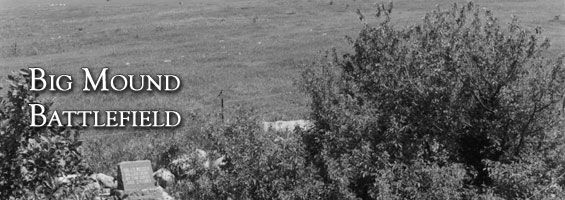We’ve launched a new web portal! Visit findhistory.nd.gov to search our collections.
Due to a road closure, the Killdeer Mountain Battlefield State Historic Site is temporarily closed.

The Big Mound Battlefield State Historic Site overlooks the site of the July 24, 1863, Battle of Big Mound. This was the first major battle fought in Dakota Territory by General Henry H. Sibley’s Minnesota volunteers. It was the beginning of a week-long series of running battles that ended with the escape of the Native people to the west side of the Missouri River (see Sibley’s and Sully’s Northwest Indian Campaigns of 1863). This historic site lies ten miles north and east of Tappen, Kidder County.
In July 1863 people of the Sioux Nation were heavily engaged in the seasonal buffalo hunts. Many Dakota people had joined their Yanktonai relatives on the rich hunting lands between the James and Missouri Rivers. Tȟatȟáŋka Nážin (Standing Buffalo), Ožúpi (Sweet Corn), and other Sisseton and Wahpeton leaders who favored peace had led their people to the Big Mound area. Other groups of Dakotas, led by Iŋkpáduta (Scarlet Point) and other leaders who favored continued resistance, were also camped nearby to hunt. Some Hunkpapa Lakotas also crossed the Missouri River to join the hunt. They included Tȟatȟáŋka Íyotake (Sitting Bull), Phizí (Gall), and Nážin Maȟtó (Standing Bear).
Čhaŋhdéška Máza (Iron Hoop), a Sisseton Dakota, was one of the buffalo hunters at Big Mound. Years later he recalled, “One man on horseback went quite aways ahead and got up on top of a hill and immediately turned around and came back towards where we were, and said that all the Americans in the land were close onto us.” (1) As Sibley’s column approached the village on July 24, warriors and leaders from the village approached for a conference. Many of the Dakota people who had not been involved in the conflict in Minnesota wanted to discuss surrender. Others did not wish to do so, but a military clash did not appear eminent.
By noon, scouts had informed General Sibley that there were many Indians a few miles away. Sibley ordered the troops to set up camp (later named Camp Sibley) and to prepare trenches and breastworks (temporary fortifications) for defense.
Some of the scouts took up a position some four hundred yards south of the main camp, where they were approached by Dakota Indians who asked to parley with General Sibley. Dr. Josiah S. Weiser, chief surgeon, 1st Regiment of the Minnesota Mounted Rangers, spoke Dakota and was assisting in the discussions when he was unexpectedly shot by one of the Dakotas. Both parties scurried for cover while exchanging gunfire and retreating to defensible positions. Several chiefs and elders caught in the open, were killed by the soldiers. The chance of a peaceful outcome was gone.
The troops setting up camp formed into battle lines. Heavy fighting broke out in a large ravine running from the top of the surrounding plateau down to the campsite. Sibley moved up the hillside on the east side of the ravine to establish a command post on high ground, accompanied by a battery of six-pound field cannons. From several progressively higher gun positions, the artillery shelled people concealed in the ravine, until the pressure of the artillery and advancing infantry forced them to retreat toward the top of the plateau.
On the eastern side of the battlefield, the Sixth Minnesota Infantry was advancing uphill against lighter opposition. When they topped the bluff line they turned south, driving the Sioux before them. On the west, McPhail’s Rangers circled west out of Camp Sibley, cutting off attack from the exposed side of the camp. The cavalry established an effective blockade, preventing the Indians from slipping off the plateau to the west. The Seventh Infantry reached the top of the plateau and sandwiched the Sioux between themselves and McPhail on the west (see McPhail’s Butte Overlook).
McPhail’s troops pursued the Sioux to Dead Buffalo Lake, one mile north of the present-day town of Dawson. Receiving orders to return to the main camp, the troops marched most of the night to return to Camp Sibley. Sibley’s men had fought their first major battle with no food and little water; some had covered nearly fifty miles during the engagement.
For their part, the Sioux warriors, by conducting a fighting retreat, had delayed the soldier’s advance until their village could be evacuated. This successful retreat continued until they crossed the Missouri River. Included in the flight west was the Dakota family of Charles A. Eastman, who was four years old at the time. His later description of how the men fought to gain time for their families to cross the river is applicable to the whole journey:
The Washechu (white men) were coming in great numbers with their big guns, and while most of our men were fighting them to gain time, the women and the old men made and equipped the temporary boats, braced with ribs of willow. Some of these were towed by two or three women or men swimming in the water and some by ponies. It was not an easy matter to keep them right side up, with their helpless freight of little children and such goods as we possessed. (2)
The battlefield is now privately owned farmland with scant evidence of the conflict. The place where Dr. Weiser was killed is marked by a stone fence and granite headstone mounted on a boulder.
Endnotes
SHSND Address:
612 East Boulevard Ave.
Bismarck, North Dakota 58505
Get Directions
SHSND Hours:
Museum Store: 8am - 5pm M-F; Sat. & Sun. 10am - 5pm.
State Archives: 8am - 4:30pm., M-F, except state holidays, and 2nd Sat. of each month, 10am - 4:30 pm.
State Historical Society offices: 8am - 5pm M-F, except state holidays.
Contact SHSND:
phone: 701.328.2666
email: history@nd.gov